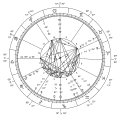Early Irish astrology
| Astrology |
|---|
 |
| Background |
| Traditions |
| Branches |
| Astrological signs |
| Symbols |
It is unclear whether a form of Early Irish astrology existed prior to contact with Western astrology, as the earliest Irish language sources are simply translations from standard Western sources. Historian Peter Berresford Ellis argues that although there is evidence of the development of Irish astrology from the 7th Century AD onwards, anything earlier is left to conjecture based on continental Celtic artifacts like the Coligny calendar and reconstructions from historical documents.[1]
While the pre-Celtic megaliths in Ireland are often aligned with solar and lunar phenomena, no evidence has been found for the type of planetary symbol system as seen in other cultures' systems of astrology.
Before Christianity
Peter Berresford Ellis has speculated on possible
After Christianity
Early Middle Ages
The introduction of
High and Late Middle Ages
Starting from the 11th century,
See also
References
- ^ a b Ellis, Peter Berresford (1996). "Early Irish Astrology: An Historical Argument". Réalta. 3 (3). Retrieved 13 August 2018.
In all histories of western astrology there is a curious omission. There are no references to early Irish, nor - indeed - ancient Celtic, astrological practices.... We can trace the development of Irish astrology fairly easily from the 7th Century AD, when our records in Irish and Hiberno-Latin begin to survive. But for anything prior to this period we must, at this time, turn to Continental Celtic remains.
- ^ ISBN 0094787204.


